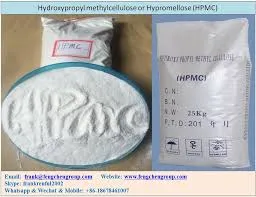
Aug . 19, 2024 21:11 Back to list
Exploring the Use of HPMC as a Versatile Excipient in Pharmaceutical Formulations
The Role of HPMC as an Excipient in Pharmaceutical Formulations
Hydroxypropyl Methylcellulose (HPMC) is a versatile excipient widely used in the pharmaceutical industry, particularly in the formulation of solid dosage forms such as tablets and capsules. As a cellulose derivative, HPMC provides a range of functional properties that enhance the performance and stability of pharmaceutical products.
Properties of HPMC
HPMC is recognized for its high viscosity, moisture retention, and film-forming capabilities. These attributes make it an ideal choice for various applications, including controlled-release formulations. Its ability to form a gel-like matrix upon hydration allows for the gradual release of active pharmaceutical ingredients (APIs), which is crucial for maintaining therapeutic drug levels in the bloodstream over extended periods.
Additionally, HPMC is a non-ionic polymer, which means it does not ionize in solution, reducing the risk of interactions with APIs and preservatives. This property is particularly beneficial in complex formulations where the stability and compatibility of ingredients are paramount. Moreover, HPMC is considered safe and is generally recognized as safe (GRAS) by regulatory agencies, making it suitable for use in pharmaceutical applications.
Applications in Tablet Formulation
In tablet development, HPMC serves multiple functions. It is commonly used as a binder to hold the tablet ingredients together, ensuring structural integrity during the tableting process and subsequent handling. The binding properties of HPMC allow for the production of tablets with desirable mechanical strength, which is essential for consistency and quality.
Beyond its role as a binder, HPMC can also be utilized as a disintegrant, promoting the rapid breakup of tablets in the gastrointestinal tract. Its incorporation into immediate-release formulations enhances the dissolution and bioavailability of the API, contributing to a more effective therapeutic outcome.
hpmc excipient

In contrast, in sustained-release formulations, HPMC creates a gel barrier that slows the release of the drug, helping to prolong the duration of action. This dual functionality of HPMC—acting as both a binder and a disintegrant depending on the formulation—illustrates its versatility and importance in drug development.
Advantages Over Other Excipients
One of the significant advantages of HPMC over other excipients is its ability to maintain performance across a range of pH levels. Many traditional polymers may lose efficacy in extreme pH environments, which can limit their applicability. However, HPMC maintains stable viscosity and consistent drug release profiles, offering formulators greater flexibility in designing effective delivery systems.
Furthermore, HPMC is compatible with a wide variety of APIs, including hydrophobic compounds that are often challenging to formulate. Its water-soluble nature facilitates the development of formulations that can be easily processed and administered, enhancing patient compliance and experience.
Regulatory Considerations
As pharmaceutical regulators continue to emphasize the importance of excipient quality and consistency, HPMC stands out for its well-defined standards of production and characterization. The regulatory framework surrounding HPMC ensures that it meets the necessary specifications for purity, potency, and performance, further solidifying its reputation within the industry.
Conclusion
In conclusion, HPMC is a crucial excipient in the pharmaceutical industry, known for its multipurpose functionality and compatibility with various formulations. Its unique properties enhance the stability, efficacy, and patient acceptability of pharmaceutical products. As research and development in drug formulation continue to evolve, HPMC will likely remain an essential component in the creation of innovative and effective therapeutics.
-
Versatile Hpmc Uses in Different Industries
NewsJun.19,2025
-
Redispersible Powder's Role in Enhancing Durability of Construction Products
NewsJun.19,2025
-
Hydroxyethyl Cellulose Applications Driving Green Industrial Processes
NewsJun.19,2025
-
Exploring Different Redispersible Polymer Powder
NewsJun.19,2025
-
Choosing the Right Mortar Bonding Agent
NewsJun.19,2025
-
Applications and Significance of China Hpmc in Modern Industries
NewsJun.19,2025







